Perhaps the most human of activities—the creation of art and the contemplation of beauty and meaning in objects—could in fact become a new frontier for artificial intelligence (AI).
 Is it actually possible for an algorithm to judge the value of art and antiques? To recognize fine details like signs of wear, repair, and original workmanship? Or to accurately determine an item’s provenance and single-out the authentic masterpiece from a collection of replicas? Lastly, can AI put an appropriate price tag on an item that takes into consideration diverse variables like fluctuating market trends, geography, and cultural factors?
Is it actually possible for an algorithm to judge the value of art and antiques? To recognize fine details like signs of wear, repair, and original workmanship? Or to accurately determine an item’s provenance and single-out the authentic masterpiece from a collection of replicas? Lastly, can AI put an appropriate price tag on an item that takes into consideration diverse variables like fluctuating market trends, geography, and cultural factors?
At Mearto.com, it’s our job to appraise antiques and art. We connect potential sellers with appraisal experts and provide answers within a matter of hours. One of the questions that keeps us awake at night is, “Will AI ever make human appraisers obsolete? How soon could it happen, and what would that transition look like?”
That’s why we took it upon ourselves to interview hundreds of antique and art collectors, professional appraisers and even computer scientists specializing in AI—to get a better grasp on the situation and ensure that Mearto.com stays at the technological forefront of the appraisal business.
The expert’s touch: How modern-day appraisers work
Today, appraisals are nearly always the result of a partnership between man and machine. Appraisers make use of extensive databases to research and compare prices on similar items. So far, this partnership has proved extremely beneficial.
These databases, containing information from millions of auctions, make both the appraiser’s job easier and improve the overall accuracy of appraisals. Along with the use of high resolution images and other online media, the utilization of auction databases has taken online appraisals to the next level.
What does a professional appraiser think?
Erin Marie Wallace has been a professional appraiser for several years, and in an average month examines hundreds of items. She agreed to share her perspective on the intersection of technology and appraisals.
Can you describe the current role of technology in the appraisal business
Technology is an amazing tool that can benefit everyone involved in the appraisal process. It is through technology that individuals and businesses can connect on a global scale with subject matter experts and specialists. Technology can also be an invaluable reference tool for a professional appraiser.
What is the current role of databases in professional appraisal?

Several types of databases play important roles in my research. Some of the most reliable databases I use are those compiled by museums relating to their permanent collections. These databases typically rely on scholarly research conducted by subject matter experts. Additionally, databases of digitized books, periodicals and pamphlets are invaluable when researching a particular item’s history. There are also several different databases available that provide aggregate prices from public auctions.
How do you see this changing in the future?
In the future, I expect that the role of professional appraiser will become even more entwined with technology. A successful appraiser must understand how to integrate technology with their own experience, and make good use of available resources like databases.
Do you believe it’s possible for AI to replace professional art appraisers?
I’m not sure that it could successfully appraise anything fully without the guidance of an appraisal professional.
This is an interesting question, and one that I think about frequently. Currently, AI can recognize items and locate comparable online items. This technology is still lacking in its ability to critically compare items or judge the validity of information given about items. That information is only as good as the knowledge and credentials of the person posting it, a factor that AI has difficulty with. Ultimately, AI’s major shortcoming is in its lack of connoisseurship. This is the ability to think critically about the item being examined, based upon experience and recognition of certain nuances. For example, let’s imagine we are evaluating an unsigned Picasso intaglio etching. AI can find similar etchings in the market, but can it determine if the etching is authentic or if the person posting the item is describing it accurately and honestly? Can it gauge important information regarding the etching’s provenance?
What categories of antiques or art do you think AI could appraise?
Until AI can eliminate human error, I’m not confident that it could automatically generate an appraisal on its own. That being said, it will surely become a more and more effective tool in all categories of antiques and art.
What are some examples of items that AI would never be able to appraise successfully?
I’m not sure that it could successfully appraise anything fully without the guidance of an appraisal professional.
How would an AI appraisal look?
To a limited extent, machine learning has already been utilized in determining the value of antiques and art. Algorithms can automatically determine the Cm2 prices of paintings by referencing sizable art sale databases.
For jewelry, stricter parameters are defined - material, size, provenance, etc.
 However, this kind of machine learning is quite different than true AI. Machine learning is a highly effective tool for sorting large datasets, identifying trends and even forming predictive models. True AI, on the other hand, interprets data in a way that we would recognize as human or near-human, taking into account complex and often subjective factors.
However, this kind of machine learning is quite different than true AI. Machine learning is a highly effective tool for sorting large datasets, identifying trends and even forming predictive models. True AI, on the other hand, interprets data in a way that we would recognize as human or near-human, taking into account complex and often subjective factors.
Human appraisers rely on extensive first-hand experience, a deep understanding of provenance and authenticity, and a subtle eye for detail to determine the price of an item.
It’s exactly these traits that would need to be demonstrated by an appraisal algorithm for it to be labelled ‘AI.’
We asked experts in computer science and AI on Quora about their thoughts on this topic.
“Will artificial intelligence ever be able to replace a professional antique and art appraiser?”
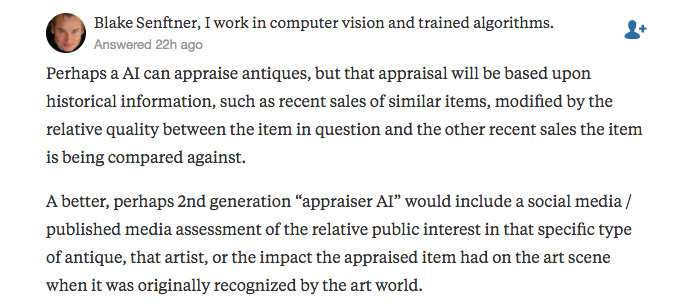
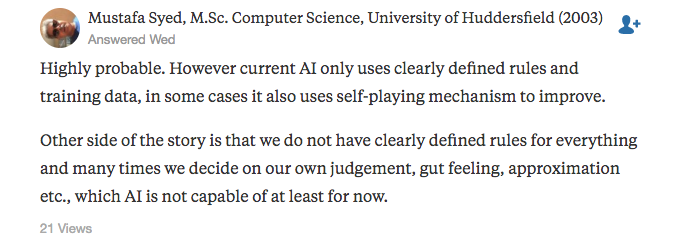
Survey shows low confidence in AI replacing appraisers
We conducted a survey with Mearto.com visitors to gauge how people feel about the future of AI appraisal algorithms. All respondents previously expressed interest in determining the value of their art, antiques or collectibles. We asked them: how likely is it that AI will replace human appraisers? They were then asked to select the item categories that they felt were most or least likely to be appraised by AI in the future.
Overall, respondents expressed some doubt as to whether or not AI will ever be able to replace human appraisers. Almost 50% of respondents believe that this will ‘probably not’ or ‘definitely not’ occur. In contrast, 33% of respondents believe that it will ‘very probably’ or ‘definitely’ happen. As of yet, it’s not exactly clear what the future will bring.
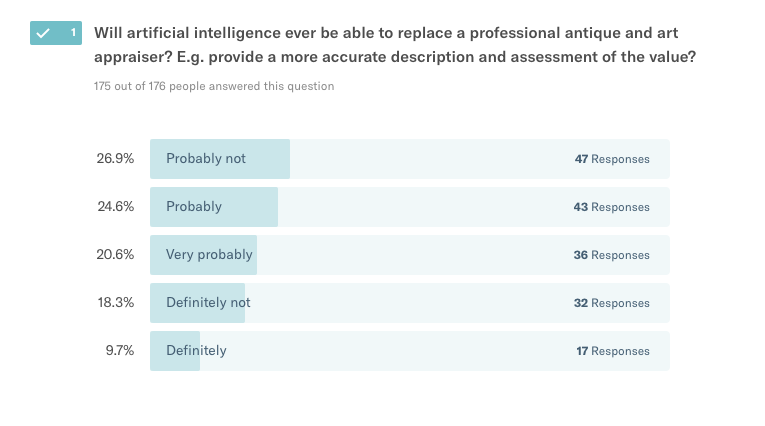
When asked ‘In what category do you think AI will be most successful replacing professional appraisers,’ the top vote at around 36% of respondents was coins and stamps. Paintings and watches came in second and third respectively, each with about 20% of the total vote.
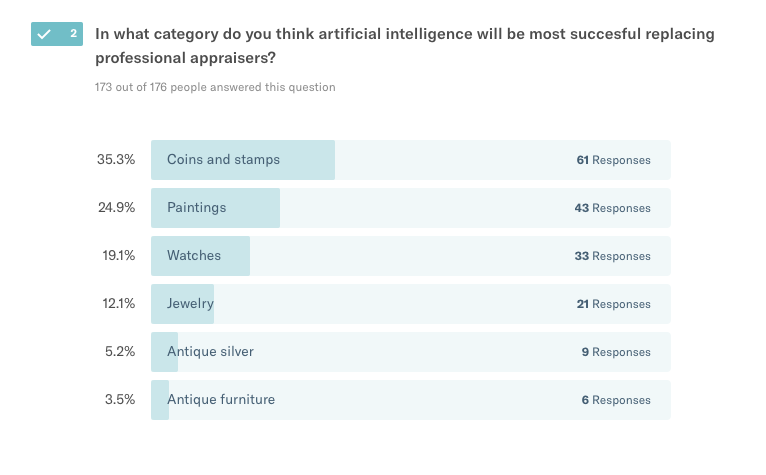
When asked ‘In what category do you think it will never happen,’ paintings came out on top. Almost 50% of respondents believe that paintings will never be appraised by AI, followed by 23% for antique furniture.
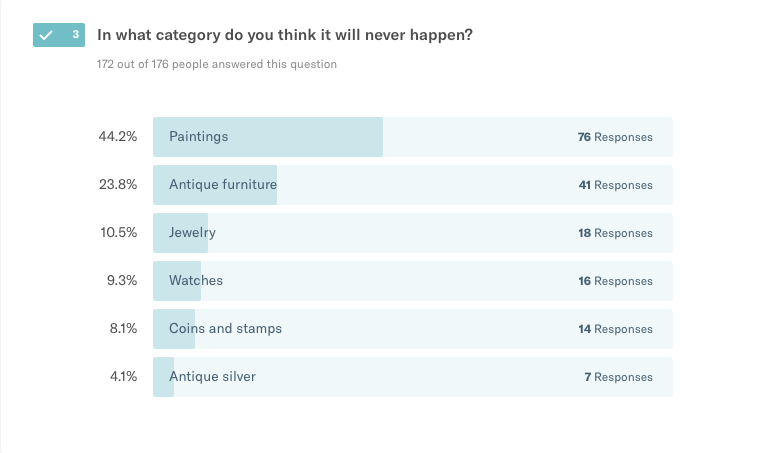
Conclusions
The art and antique market will always be dynamic. Proof of this fact is in the very nature of auctions. Ultimately, an item is worth whatever someone is willing to pay for it; this may be far above or below the anticipated sale price. Even top experts at auction houses occasionally miss their mark, simply because auctions are always subject to some degree of chance.
AI has now reached a point where it can rapidly optimize search engine results, anticipate heart failure by monitoring a person’s physiology, and even beat top players in chess and other games. While diverse, all of these tasks are based on well-structured data and rules. The same must hold true when developing a self-learning AI appraisal algorithm.
This process will most likely involve feeding a particular algorithm information from various databases, and then having human experts evaluate the algorithm’s predictions. These predictions would then be compared to actual auction results. Given enough repetitions, it would be possible to statistically determine if the AI appraiser performs better than its human counterparts.
AI appraisal algorithms will naturally diversify to suit the needs of different categories. The algorithm used to appraise coins will be fundamentally different than the one used to appraise paintings, for instance. These category-specific algorithms will emerge through extensive testing and verification by human experts.
One big question still remains: will it ever be possible for a computer to think and feel the way a human appraiser does? Can an appraisal algorithm develop its own ‘gut feeling’ or ‘sixth sense’ to fall back on when logic is not enough? Finally, will AI ever be able to accurately judge the true value (artistic, cultural, sentimental, historical, etc) of art and antiques?
At least for the foreseeable future, it doesn’t look likely.
For questions and interviews about this article, please contact Mads Hallas, [email protected]
Feel free to use any material from this page as long as you reference the original source
Image credentials: Designed by Freepik